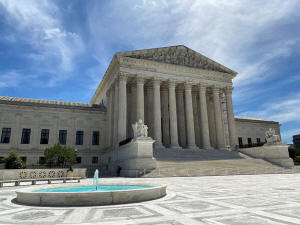US Supreme Court divisions expected to be exposed as final rulings loom
 Send a link to a friend
Send a link to a friend
 [June 24, 2024]
By John Kruzel and Andrew Chung [June 24, 2024]
By John Kruzel and Andrew Chung
WASHINGTON (Reuters) - The U.S. Supreme Court, with its 6-3 conservative
majority, managed to bridge its ideological divide in major rulings this
month involving constitutional gun rights and access to the abortion
pill, but that could change as the court heads into what may be the
final week of its term.
Decisions are due in major cases involving Donald Trump's claim of
presidential immunity from prosecution, an Idaho abortion ban that makes
no exception to protect the health of pregnant women, and a doctrine
called "Chevron deference" that long has bolstered federal regulations
against legal challenges. Those cases are expected to once again expose
the fault lines between the court's conservative and liberal justices.
"So far, the term has been less ideologically defined than the last
two," said Erwin Chemerinsky, dean of the University of California
Berkeley Law School. "But I really think it is (this) week's decisions
that will determine how we think of the term."
Two years ago, the court's conservatives powered rulings rolling back
abortion rights and widening gun rights. Last year, they rejected
race-conscious admissions policies long used by colleges and
universities to increase enrollment of Black and Hispanic students.

Some justices have come under fresh scrutiny for their actions away from
the bench, including reports that flags associated with Trump's attempts
to overturn his 2020 election loss flew outside Justice Samuel Alito's
homes in Virginia and New Jersey, and fresh revelations about Justice
Clarence Thomas accepting undisclosed travel from a wealthy benefactor.
The American public has come to view the court through a partisan lens,
with 69% of Republicans, but just 27% of Democrats, viewing it
favorably, according to a May Reuters/Ipsos poll.
The justices are expected to complete their term either this week or
next, with rulings in 14 argued cases - including some of the most
important ones - still outstanding.
Based on the proportion of cases decided by this point in a term that
started in October, the court is having its second-slowest term since
1946, according to Adam Feldman, a legal scholar who tracks court data
on his Empirical SCOTUS blog. In that span, only the 2019-2020 term that
ended during an intense period of the COVID pandemic was slower.
Two cases of keen interest to Trump, the Republican candidate
challenging Democratic President Joe Biden in the Nov. 5 U.S. election,
are awaiting resolution. One is his bid to avoid federal prosecution on
charges relating to the former president's efforts to overturn his 2020
election loss to Biden. The other involves whether to raise the legal
bar for prosecutors pursuing obstruction charges against Trump
supporters accused in the Jan. 6, 2021, U.S. Capitol attack.

[to top of second column]
|

A general view of the U.S. Supreme Court building in Washington,
U.S., June 1, 2024. REUTERS/Will Dunham/File Photo

Trump himself was hit with two obstruction-related charges in a
four-count criminal indictment obtained in August 2023 by Special
Counsel Jack Smith. The Supreme Court's decision to hear arguments
over presidential immunity and to then wait until the end of its
term to issue a ruling have reduced the chances of a jury deciding
that criminal case before the Nov. 5 election - if the justices even
allow it to proceed.
AGENCY POWERS
The court last month ruled 7-2 - with four conservative justices
joined by all three liberals - to uphold the Consumer Financial
Protection Bureau's funding mechanism, a decision in a case that had
posed an existential threat to that agency. But U.S. regulatory
agencies could still suffer major blows in cases still be to decided
- reflecting a long-running conservative effort to weaken what they
call the "administrative state."
One case takes aim at the legality of proceedings conducted by
Securities and Exchange Commission in-house judges. Another targets
"Chevron deference," a key principle of administrative law for
decades. Dating to a 1984 Supreme Court precedent involving the oil
company Chevron, it calls on judges to defer to reasonable
interpretations by federal agencies of laws deemed to be ambiguous.
Also to be decided are three cases involving the power of social
media companies to curb content on their platforms that they deem
objectionable.
During its current term, the Supreme Court has reined in several
decisions by the New Orleans-based 5th U.S. Circuit Court of
Appeals, one of the most conservative federal appellate courts.
The justices have overturned or thrown out five of the seven 5th
Circuit rulings they have addressed so far. These included the
court's unanimous June 13 ruling preserving broad access to the
abortion pill mifepristone, and an 8-1 ruling last Friday - with
five conservative justices joined by the three liberals - that
upheld a federal law that makes it a crime for people under domestic
violence restraining orders to have guns.

The court is next scheduled to issue rulings on Wednesday.
"As always, most of the blockbuster cases will come down in the last
week," Chemerinsky said.
(Reporting by John Kruzel; Editing by Will Dunham and Scott Malone)
[© 2024 Thomson Reuters. All rights reserved.]This material
may not be published, broadcast, rewritten or redistributed.
Thompson Reuters is solely responsible for this content. |